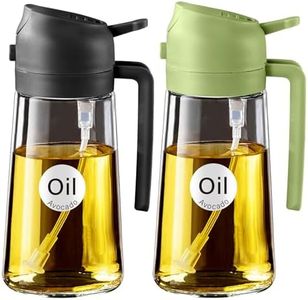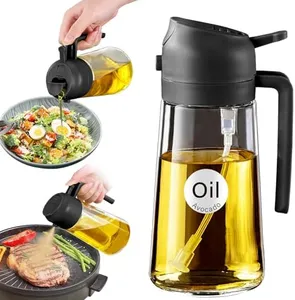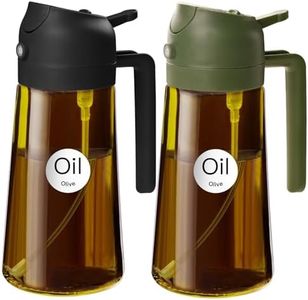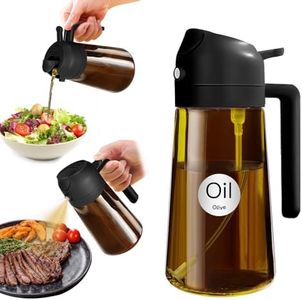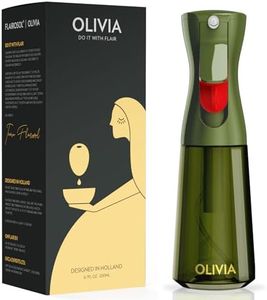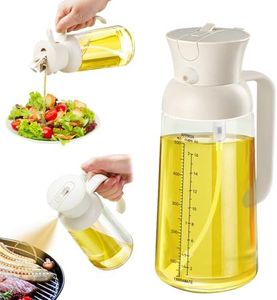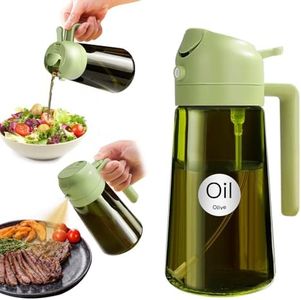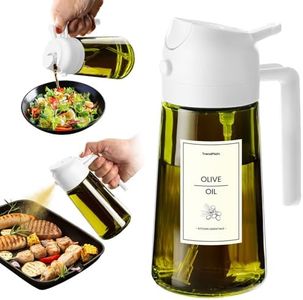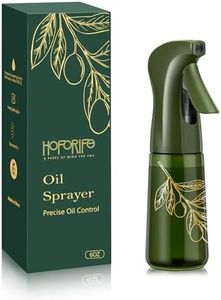We Use CookiesWe use cookies to enhance the security, performance,
functionality and for analytical and promotional activities. By continuing to browse this site you
are agreeing to our privacy policy
10 Best Olive Oil Sprayers
From leading brands and best sellers available on the web.Buying Guide for the Best Olive Oil Sprayers
Picking an olive oil sprayer can really make meal preparation easier, healthier, and more enjoyable. These sprayers help you use just the right amount of oil, adding flavor and moisture without pouring on too much. The right choice depends on how you'll use it—whether for greasing pans, dressing salads, or adding a finishing touch to your food. Understanding the key features will help you make the best pick for your kitchen habits.MaterialMaterial refers to what the sprayer is made from, and this is important for safety, durability, and how easy it is to clean. Most olive oil sprayers are made from either glass, stainless steel, or plastic. Glass is non-reactive and lets you see how much oil is left, but it can break if dropped. Stainless steel is strong and looks good in a kitchen, but you can't see inside and it might be heavier. Plastic is lightweight and affordable, but may absorb oil smells over time and can be less durable. If you’re often clumsy or have kids helping in the kitchen, a sturdy stainless steel or certain types of thick plastic might be best; if you want to keep an eye on the oil level and are careful, glass is a nice choice.
Spray MechanismThe spray mechanism is how the sprayer delivers oil—typically either a manual pump or a trigger. This matters because it affects how easy the sprayer is to use and how evenly it distributes oil. Pump styles usually require you to build up air pressure inside, while trigger sprays work more like typical cleaning bottles. Pump sprayers can often give finer, more controlled mist but take more effort, while trigger types are simpler but sometimes spray unevenly. If you want delicate control for salads or finishing dishes, a pump might suit you. If you mostly want to grease pans or coat food quickly, a simple trigger action may be easier.
CapacityCapacity is the amount of oil the sprayer can hold. This is important because it affects how often you’ll need to refill the sprayer and how much space it takes up. Smaller capacities (under 6 ounces) are compact, great if you use oil sparingly or want to keep several sprayers for different oils. Mid-sized versions (6–12 ounces) are the most versatile for everyday cooking. Bigger sprayers can be handy for frequent cooking but may be bulkier and oil can go stale if stored too long. Match the size to your cooking habits—if you only use olive oil for salads or finishing dishes, a small one might suffice, but if you use oil often for grilling or roasting, a larger capacity may save you time.
Ease of CleaningEase of cleaning relates to how simple it is to keep the sprayer hygienic and free of oil buildup. Since oils can spoil over time, regular cleaning is necessary. Sprayers that come apart into several pieces are usually easier to clean thoroughly. Some are dishwasher-safe, which is very convenient. If you're likely to wash by hand, consider shapes without lots of corners or crevices. If you want to minimize kitchen chores, look for a sprayer marked as easy to clean or dishwasher-safe.
Nozzle Type and Spray PatternNozzle type and spray pattern describe how the oil is dispersed. Some nozzles deliver a fine mist, while others shoot a stream or a wider spray. This is important because a fine mist helps control oil for dressing salads or finishing cooked food, while a stronger stream is better for coating pans. Adjustable nozzles can switch between mist and stream for more flexibility. Choose fine mist capabilities if you prioritize even, light oil coverage, or look for adjustable settings if you want to use the sprayer for different purposes.
Non-Clogging DesignA non-clogging design means the sprayer is made to work smoothly with thicker liquids like olive oil, which can sometimes block standard spray mechanisms. This is important because clogging can make the sprayer frustrating or unusable. Sprayers designed with wide tubes or special nozzles can help avoid this issue. If you plan to use thicker oils or blends besides regular olive oil, prioritize a sprayer promoted as resistant to clogging for reliably smooth operation.

